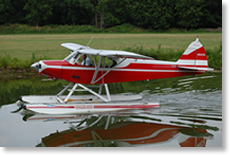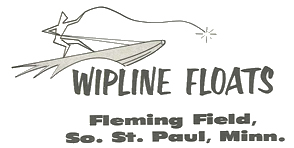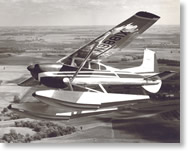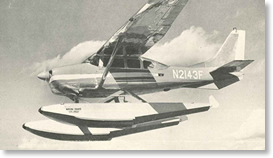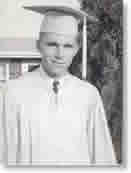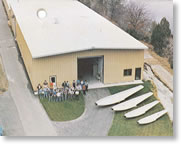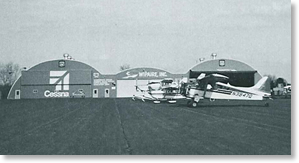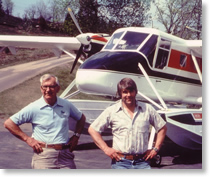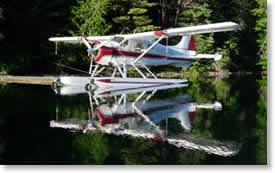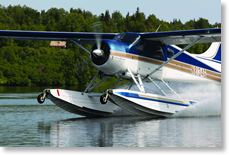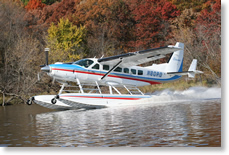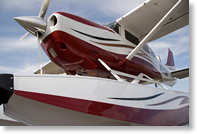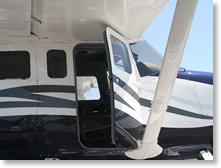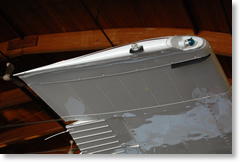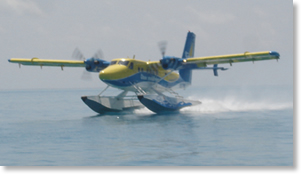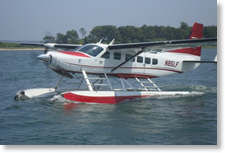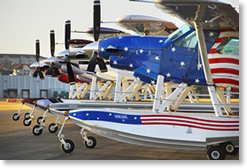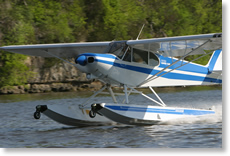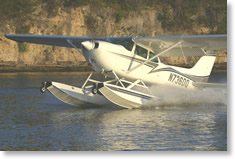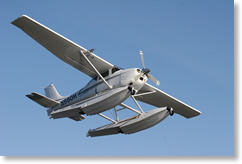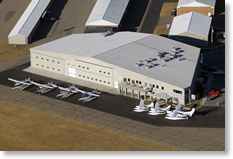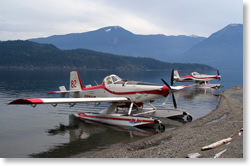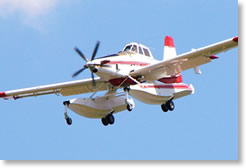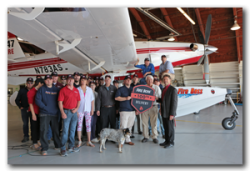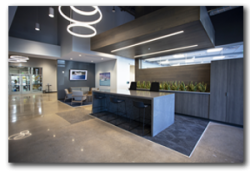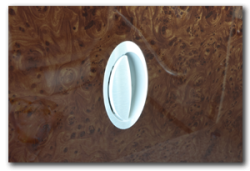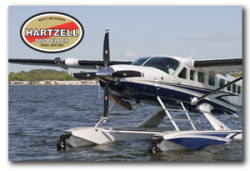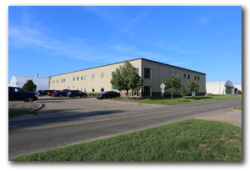1940-1950: Passion and Vision
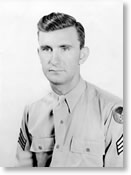 Ben Wiplinger had a strong interest in aviation long before he began working on Wipline floats. As a child, he built his own glider in the backyard of his parent’s home. Out of concern for his safety, his parents dismantled the aircraft before he could take it on its maiden voyage. His passion for aviation grew stronger as he went on to study aerospace engineering at the University of Minnesota before moving to California to work for Douglas Aircraft for a period of time. He then returned to Minnesota to work for Northwest Air Activities and Peterson-Curtiss Flying Service at the St. Paul Airport. At the age of 25, Ben was one of only six certified aircraft mechanics working in the Minneapolis/St. Paul area. Ben was drafted into the Army Air Forces of the United States before Pearl Harbor and spent time working in Albuquerque, New Mexico, where he developed a pre-oiling system to help the performance of the bombers. He was awarded several decorations by the military for this engineering contribution.
Ben Wiplinger had a strong interest in aviation long before he began working on Wipline floats. As a child, he built his own glider in the backyard of his parent’s home. Out of concern for his safety, his parents dismantled the aircraft before he could take it on its maiden voyage. His passion for aviation grew stronger as he went on to study aerospace engineering at the University of Minnesota before moving to California to work for Douglas Aircraft for a period of time. He then returned to Minnesota to work for Northwest Air Activities and Peterson-Curtiss Flying Service at the St. Paul Airport. At the age of 25, Ben was one of only six certified aircraft mechanics working in the Minneapolis/St. Paul area. Ben was drafted into the Army Air Forces of the United States before Pearl Harbor and spent time working in Albuquerque, New Mexico, where he developed a pre-oiling system to help the performance of the bombers. He was awarded several decorations by the military for this engineering contribution.
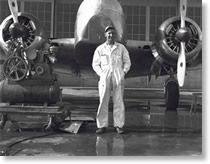 After WWII, Ben returned once again to his roots in Minnesota and began converting surplus military aircraft into corporate aircraft at South St. Paul Airport. By the close of the 1940s, Ben was operating Wiplinger Aircraft Service, an FBO offering fuel service, aircraft sales, maintenance, restoration and upholstery.
After WWII, Ben returned once again to his roots in Minnesota and began converting surplus military aircraft into corporate aircraft at South St. Paul Airport. By the close of the 1940s, Ben was operating Wiplinger Aircraft Service, an FBO offering fuel service, aircraft sales, maintenance, restoration and upholstery.
During the 1950s, Ben grew and expanded his scope of services. He purchased his first seaplane in 1951 and began flying north on fishing expeditions, thus beginning his passion for seaplane flying. He even developed an improved hydraulic system for his Edo floats. Ben sold 3M their first corporate aircraft, N3M, in 1956 while still pursuing his interest in seaplanes. One of 3M’s current aircraft still carries the same registration number. In 1959, Ben sold his FBO business to focus on the next chapter of Wiplinger Aircraft.
Milestones
- 1946 – Wiplinger Aircraft Service

After the war Ben bought surplus aircraft parts and Stearman aircraft to resell as civil aircraft. Soon he was doing maintenance on Norseman’s, Beech Staggerwings and Lodestars. Then Ben started an FBO selling Cubs, Taylorcrafts and Aeroncas. - 1947 – Wip-Liner Introduced
 Ben saw a need for executive aircraft in the “pre corporate jet” era and he developed a high class interior fitting for DC-3’s and Lodestars. Ben sold his first “Wip-Liner” in 1947.
Ben saw a need for executive aircraft in the “pre corporate jet” era and he developed a high class interior fitting for DC-3’s and Lodestars. Ben sold his first “Wip-Liner” in 1947. - 1951 – Ben’s First Seaplane

In 1951 Ben purchased his first seaplane, a Piper Cub on Edo 1400 floats that Wip still owns today, now on Wipline 2100 floats. - 1959 – Ben Sells FBO and Starts Building Floats
After having trouble with his Edo Float’s gear retraction system Ben decided to design his own. He designed and built a hydraulic landing gear that he began selling as a modification. Eventually he decided to put all his ideas for improvement together and build a new float. He sold his FBO business and got to work designing and building these innovative new floats.
1960s: Wipline Inc is Born
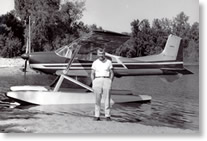
In 1960 Ben officially incorporated Wipline Inc and set to work creating his first set of floats. He purchased a Cessna 185, N9881X, to test the floats on.
To create a better float Ben worked with experts at 3M to develop a metal bonding technique that would allow him to use fewer rivets and therefore acheive a smoother and lighter float. It took 3 years and $8000 to get the patent on this process but Ben knew it was the way to go.
Another innovative idea was the flat top on the float. This allowed pilot and passengers to maneuver into and out of the airplane with much less risk of taking an impromptu swim.
He soon sold his first set of floats. They were sold in 1962 to Ontario Central Airlines.
Soon the Cessna 185 was Certified on 3700 and 3900 Floats followed by the 206 on 3700, 3900 and 3730’s.
The Wipline Inc facilities were all located on Fleming Field and they produced around 30 sets of floats in these first 10 years.
Milestones
- 1960 – Wipline Inc.

Ben Wiplinger founded Wipline Inc. in 1960 and set up shop building and testing his new floats on Fleming Field in South St. Paul, MN. - 1961 – Testing Begins

Ben buys a Cessna 185 to use for testing the newly designed 3700 Wipline Floats - 1962-The First Sale
First set of Wipline Floats Sold to Ontario Central Airlines - 1963 – Certification

Cessna 185 185A-E and A185E approved on 3700,3800 and 3900 floats - 1965 – Cessna 206 on Wipline Floats

206, P206, U206, P206A, U206A, TU206A, TP206A, U206B, TU206B, U206C, TU206C, U206D, TU206D, U206E and TU206E approved on 3700 and 3900 floats - 1969 – Wipline 3730 Floats
206, P206, U206, P206A, U206A, TU206A, TP206A, U206B, TU206B, U206C, TU206C, U206D, TU206D, U206E and TU206E approved on Wipline 3730 Floats
1970s: The Next Generation
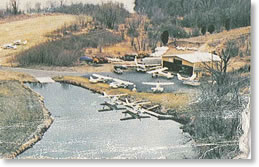
Bob began working at Wipline Inc. in 1970 after receiving his aeronautical engineering degree from U of M and spending a few years working for Honeywell.
In 1971, after Ben purchased the 160 acres of land along the Mississippi River, float manufacturing moved down to the River Road facility and the seaplane base was established.
In 1974 Bob expanded our range of services by founding Wipaire, performing maintenance as a certified Cessna service center at Fleming Field.
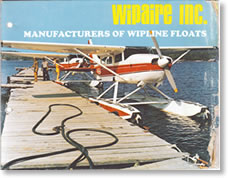
Wipline Inc and Wipaire came together in 1979 when Bob purchased Wipline Inc from his dad.
During the late seventies Ben and Bob decided to tackle a huge project, the Nomad. Though the Nomad Aircraft had a short production run and only resulted in a few sales the design for the Nomad float opened the door to other larger scale projects and became the foundation for the popular Wipline 8000 Float.
Milestones
- 1970 – Bob Joins the Company

Bob begins working at Wipline Inc. after receiving his aeronautical engineering degree from U of M and working for Honeywell. - 1971 – Manufacturing Moves to River Rd

Float Manufacturing Moved from Fleming Field to a new Location at 8520 River Road where it remained until moving to it’s current location in 2012.Cessna A185E is certified on 3730 Floats
- 1974 – Wipaire Inc

Bob Started Wipaire, Inc. as a Cessna Dealership and Maintenance Center - 1979 – Wipline Inc and Wipaire Inc Merge
Bob buys Wipline Inc and combines it with Wipaire
The 1980s: A Growing Company
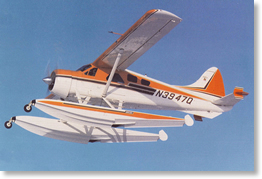 The 80’s kicked off with the introduction of the Wipline 6000 Float for the de Havilland Beaver in 1982. More than 10 modifications for the Beaver were introduced over then next few years allowing Wipaire to transform the Beaver to a true Seaplane workhorse.
The 80’s kicked off with the introduction of the Wipline 6000 Float for the de Havilland Beaver in 1982. More than 10 modifications for the Beaver were introduced over then next few years allowing Wipaire to transform the Beaver to a true Seaplane workhorse.
In 1988 the Wipline 8000 Floats for the Cessna Caravan were released. This was one of our most popular float models until it was superseded by the Wipline 8750 float.
Rick Wahlman was brought on board in ‘89 to start an Avionics department to better serve our customers. The Refinishing department was also started at this time and allowed us to provide in house paint services to be sure our customers left with their dream plane.
By the mid-80’s Wipaire had grown to 35 employees and had sold an incredible 700 sets of floats.
Milestones
- 1980 – The Nomad

Nomad Approved on 9500 Amphibian Floats. During the late seventies Ben and Bob decided to tackle a huge project, the Nomad. Though the Nomad Aircraft had a short production run and only resulted in a few sales the design for the Nomad float opened the door to other larger scale projects and became the foundation for the popular Wipline 8000 Float. - 1982 – Beaver on Wipline 6000 Floats

6000 Amphib and Seaplane Float approved on DHC2 MKI - 1985 – Super Beaver

The Wipaire Super Beaver is introduced. This incorporated all the Beaver mods offered by Wipaire, plus an airframe restoration second to none. - 1988 – Cessna Caravan

Wipline 8000 Floats are approved for the Cessna Caravan. This will prove to be one of our most popular float models. - 1989 – New Services

Avionics and Refinishing departments are started.
1990s: Reaching New Markets
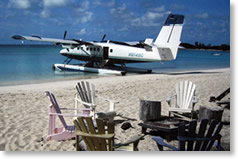 The 90’s saw many new modifications and float certifications. The Cessna 206 co-pilot door and “Wip” tips wing extensions, gross weight increases for the Piper Cub and Cessna Caravan, and numerous other modifications were certified.
The 90’s saw many new modifications and float certifications. The Cessna 206 co-pilot door and “Wip” tips wing extensions, gross weight increases for the Piper Cub and Cessna Caravan, and numerous other modifications were certified.
Our largest floats ever, the Wipline 13000, were certified on the Twin Otter in 1992. Our interiors shop was also opened to provide a well-rounded service experience.
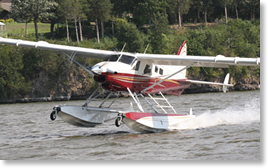 The “Boss Beaver” was introduced in 1996. It combined a selection of our beaver modifications, a turbine engine and our 6000 floats to create a true performance seaplane.
The “Boss Beaver” was introduced in 1996. It combined a selection of our beaver modifications, a turbine engine and our 6000 floats to create a true performance seaplane.
The smallest float in the Wipline family was introduced in ‘97, the Wipline 2100. The 2350, 3000 and 4000 also joined the team in the 90’s.
Milestones
- 1990 – Co-Pilot Door

Co-Pilot Door for C-206 & Wipline 4000 Floats Certified - 1991 – Wip-Tips

“Wip-Tip” Wing Extensions for Cessna 206. - 1992 – Twin Otter and Interiors

Interiors Shop Started & Wipline 13000 Floats Certified - 1994 – Caravan GWI

Wipaire receives certification on a 8360 LB Gross Weight Increase for the Cessna 208. - 1996 – Boss Beaver

The Wipaire “Boss” Beaver is certified. This turbine conversion and complete modifications package make the ultimate amphibian workhorse. - 1997 – Wipline 2100 Floats

The Wipline 2100 Float is certified adding many new models of aircraft to the Wipline Seaplane family. - 1998 – Wipline 2350 Floats

The Wipline 2350 Float is certified for the Cessna 172. - 1999 – Wipline 3000 Floats & 2000 Lb Cub

Wipline 3000 Floats Certified & 2000 LB GWI for PA-18
2000's: Still Innovating
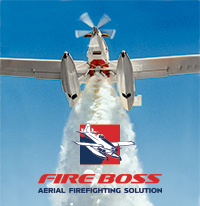 The new century kicked off with the next generation of Wiplingers coming to work for Wipaire. Nancy started in 2000 and Charlie came to Wipaire in 2003.
The new century kicked off with the next generation of Wiplingers coming to work for Wipaire. Nancy started in 2000 and Charlie came to Wipaire in 2003.
Wipaire’s main offices moved to the new Hangar 1 facility on Fleming Field in 2001.
In 2003 the Fire Boss was introduced. There are now 150+ Fire Boss aircraft in operation as an initial response air tanker fighting fires around
the globe.
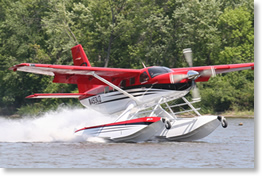 Wipaire received Supplemental Type Certification (STC) of their most recent addition to the Wipline family of products, the Wipline 7000 Amphibious Float installed on the Quest KODIAK, on June 11th, 2010. The Quest KODIAK certification program took roughly three years to complete and included 287 test flights, totaling 162 hours of flying. The hulls are modeled after the successful Wipline 13000 Floats, which have improved rough water handling qualities for float-equipped aircraft. The new floats include the traditional Wipline flat top deck for easy loading and safety. The main gear system has been completely redesigned, which improves reliability and makes for easy maintenance.
Wipaire received Supplemental Type Certification (STC) of their most recent addition to the Wipline family of products, the Wipline 7000 Amphibious Float installed on the Quest KODIAK, on June 11th, 2010. The Quest KODIAK certification program took roughly three years to complete and included 287 test flights, totaling 162 hours of flying. The hulls are modeled after the successful Wipline 13000 Floats, which have improved rough water handling qualities for float-equipped aircraft. The new floats include the traditional Wipline flat top deck for easy loading and safety. The main gear system has been completely redesigned, which improves reliability and makes for easy maintenance.
Milestones
- 2000 – Beaver GWI & Wipline 3450
Wipline 3450 Floats Certified for Cessna 206 and 185. Also the Beaver 5600 LB Gross Weight Increase was approved. - 2001 – New Headquarters

Wipaire’s Main Office Moves to a New Modern Facility on Fleming Field. We also added many of the Maule models to our Seaplane family by receiving STC’s for Wipline 2350 and 3000 Floats. - 2003 – Fire Boss Introduced

The Fire Boss amphibious water bomber is certified and begins its work as an initial response air tanker fighting fires around the globe. - 2008 – Fire Boss Upgrades

Fire Boss Dual Seat and 1600 hp Conversions are certified.
2010- Present: Wipaire Today
Milestones
- 2019 – 100th Fire Boss delivered

100th Fire Boss delivered to Air Spray, based in Chico, California. - 2022 – Westgate Remodel

Reimagined workspaces, production floor, break rooms and customer areas, bringing in elements of light and nature for a modernized environment. - Hydro-Dip capability added to Interiors

Increasing durability and expanding design options, we invested in a Hydro-Dip system for aircraft interiors. - Yukon Propeller by Wipaire and Hartzell Propeller

Full composite four blade propeller certified for wheeled and floated Caravan 208 & 208B, engineered and developed through collaboration with Hartzell Propeller - New building for Engineering

Purchased and renovated former BRS factory building at KSGS to be the site of Wipaire Engineering






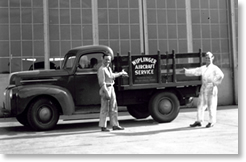
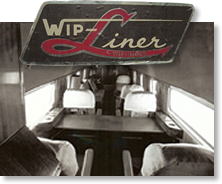 Ben saw a need for executive aircraft in the “pre corporate jet” era and he developed a high class interior fitting for DC-3’s and Lodestars. Ben sold his first “Wip-Liner” in 1947.
Ben saw a need for executive aircraft in the “pre corporate jet” era and he developed a high class interior fitting for DC-3’s and Lodestars. Ben sold his first “Wip-Liner” in 1947. 